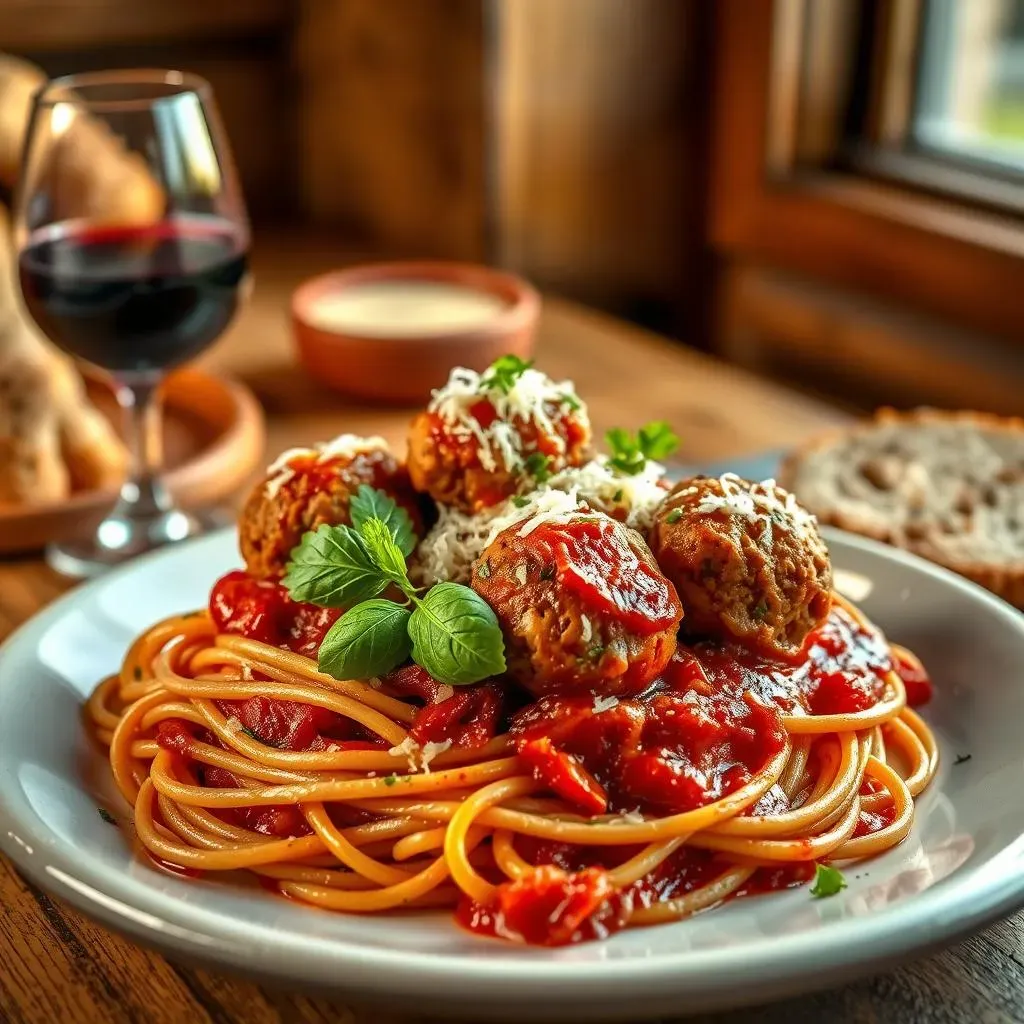Table of Contents
Are you ready to discover the best all-beef meatball recipe? Forget dry, crumbly disappointments – we're about to embark on a culinary adventure that will transform your meatball game. This isn't just another recipe; it's a journey into meatball mastery. We'll arm you with insider secrets, from choosing the perfect beef to mastering the art of the perfect blend. You'll learn foolproof techniques to ensure juicy, flavorful meatballs every single time, whether you prefer oven-baked, stovetop-simmered, or slow-cooked goodness. We'll even explore creative serving suggestions that will elevate your meatballs from simple side dish to star of the show. Get ready to impress your family and friends with meatballs so delicious, they'll be begging for seconds (and maybe thirds!). So, let's dive into the ultimate guide to crafting the best all-beef meatball recipe – your taste buds will thank you!
Tricks for Juicy & Flavorful AllBeef Meatballs

Tricks for Juicy & Flavorful AllBeef Meatballs
The Secret to Super-Juicy Meatballs
Okay, so you want juicy meatballs? Let's talk about moisture. The enemy of a juicy meatball is dryness. Think of your meatball mixture like a sponge. You want that sponge to soak up as much liquid as possible without becoming soggy. The key is a good binder. A simple mixture of breadcrumbs, milk, and egg works wonders. Let the breadcrumbs soak up the milk for a few minutes before adding the other ingredients. This creates a fantastic base that keeps the meatballs moist and tender. For extra flavor, try adding a little grated onion – it adds moisture and a subtle sweetness. Don't forget to gently mix everything together; overmixing toughens the meat. Check out our simple ground beef meatball recipe for more tips!
Another sneaky trick is to use a meat grinder. Grinding your own beef creates a finer texture, which helps to distribute the moisture evenly throughout the meatballs, resulting in a more consistent, juicy final product. If you don't have a grinder, that's fine! Just make sure to use a good quality ground beef with a higher fat content (around 80/20). The fat renders during cooking, adding incredible flavor and keeping the meatballs moist. Seriously, don't be afraid of the fat; it's your secret weapon! Want to explore more options? Check out our best meatball recipe with ground beef for extra inspiration.
Ingredient | Function | Tip |
|---|---|---|
Breadcrumbs | Binder, texture | Use fresh breadcrumbs for best results |
Milk | Moisture, flavor | Let breadcrumbs soak for 5-10 minutes |
Egg | Binder, richness | Use a large egg for better binding |
Seasoning & Flavor Boosters
Don't underestimate the power of seasoning. A simple blend of salt, pepper, garlic powder, and Italian seasoning can transform your meatballs. But don't just dump it all in! Seasoning is an art. Start with a small amount of salt and pepper, then add the other seasonings gradually, tasting as you go. Remember, you can always add more seasoning, but you can't take it away! Think of it as a symphony of flavors – each spice plays a crucial role. For extra depth, consider adding some finely grated Parmesan cheese to the meat mixture. It adds a salty, umami richness that's hard to resist. This is a total game-changer, trust me! Looking for something a little different? Try adding a pinch of red pepper flakes for a subtle kick! For more ideas, explore our beef meatball recipe ideas page.
And let's not forget the importance of fresh herbs! A sprinkle of fresh parsley or basil adds a burst of freshness and vibrancy that elevates the flavor profile to another level. Imagine biting into a meatball and experiencing a symphony of taste – savory, slightly sweet, herbaceous, and oh-so-juicy. That's the magic we're aiming for! For a bolder flavor, try adding a tablespoon or two of your favorite tomato paste to the mixture. This adds a depth of flavor that complements the beef beautifully. Don't forget to check out our ultimate beef meatball recipe for spaghetti for a complete recipe!
- Salt & Pepper: Essential base
- Garlic Powder: Savory depth
- Italian Seasoning: Classic blend
- Parmesan Cheese: Umami richness
- Fresh Herbs: Bright, fresh notes
Ingredients: What You'll Need (and Substitutions!)

Ingredients: What You'll Need (and Substitutions!)
The Star of the Show: The Beef
Let's talk about the main event: the beef! For the best all-beef meatballs, you'll want to choose a good quality ground beef. An 80/20 blend (80% lean, 20% fat) is ideal. The fat renders during cooking, keeping the meatballs incredibly juicy and flavorful. Don't be afraid of the fat; it's your secret weapon against dryness! You can certainly experiment with leaner ground beef (like 90/10), but you might need to add a little extra oil to the pan to prevent sticking. For a truly decadent experience, consider using high-quality Angus beef; the richer flavor will elevate your meatballs to a whole new level. Looking for a simple recipe? Check out our simple ground beef meatball recipe for a great starting point.
While we're focusing on all-beef meatballs today, remember that culinary creativity knows no bounds! Feel free to experiment with different cuts of beef. For example, chuck or sirloin can be ground to give a unique texture and taste. If you are feeling adventurous, try using a blend of different ground beef cuts for a complex flavor profile. Remember, the best all-beef meatball recipe is the one that *you* enjoy the most! Want to try something different? Check out our best beef meatball recipe for more inspiration.
- Ground Beef (80/20 recommended)
- Angus Beef (for a luxurious touch)
- Chuck or Sirloin (for unique textures)
The Supporting Cast: Breadcrumbs, Eggs, and More
Beyond the beef, you'll need a few key ingredients to create the perfect meatball magic. Fresh breadcrumbs are essential for binding the meat mixture and adding texture. Avoid using pre-seasoned breadcrumbs, as you'll want to control the seasoning yourself. Milk is another crucial ingredient; it helps to moisten the breadcrumbs and adds a subtle sweetness. A large egg acts as a binder, helping to hold the meatballs together. Finally, don't forget the aromatics! Finely minced onion and garlic add depth and complexity to the flavor. Need more ideas? Consider our meatball recipes using ground beef for more options.
Now, let's talk substitutions! If you're out of milk, you can substitute with water or even a little beef broth for extra savory notes. If you're vegetarian or vegan, there are plenty of meatball alternatives that use plant-based proteins and binding agents. Feel free to experiment with different types of breadcrumbs, such as panko or gluten-free options. For a richer flavor, you can also add a little grated Parmesan cheese. The possibilities are endless! For more ideas, explore our all ground beef meatball recipe.
Ingredient | Substitution | Notes |
|---|---|---|
Breadcrumbs | Panko, gluten-free crumbs | Adjust amount based on crumb type |
Milk | Water, beef broth | Water may result in slightly drier meatballs |
Egg | Flax egg (vegan) | May require additional binding agent |
Seasoning Your Success: Herbs, Spices, and Flavor Enhancers
Finally, let's not forget the magic of seasoning! A simple blend of salt, pepper, garlic powder, and Italian seasoning will create delicious meatballs, but don't be afraid to get creative. Fresh herbs like parsley or basil add a bright, fresh flavor. A pinch of red pepper flakes adds a subtle kick. For a richer, more savory taste, consider adding a tablespoon or two of tomato paste. Remember, taste as you go and adjust the seasonings according to your preferences. Our beef meatball recipe ideas page offers several alternatives.
Experimentation is key! Don't be afraid to try different combinations of herbs and spices to find your perfect flavor profile. Perhaps you'll discover a hidden gem by adding a touch of nutmeg or even a hint of cinnamon. Remember, the best all-beef meatball recipe is a reflection of your unique culinary style. Want to learn more about flavor combinations? Check out our ultimate beef meatball recipe for spaghetti for inspiration.
- Salt and freshly ground black pepper
- Garlic powder
- Italian seasoning
- Fresh parsley or basil
- Red pepper flakes (optional)
- Tomato paste (optional)
Cooking Methods: Oven, Stovetop, Slow Cooker Your Choice!

Cooking Methods: Oven, Stovetop, Slow Cooker Your Choice!
Oven-Baked Perfection
For tender, evenly cooked meatballs with a slightly crispy exterior, baking is your best bet. Preheat your oven to 400°F (200°C). Place your meatballs on a baking sheet lined with parchment paper or lightly greased with olive oil. Bake for 20-25 minutes, flipping halfway through, until cooked through and nicely browned. This method is super convenient, especially if you're making a large batch. Plus, cleanup is a breeze! For a detailed guide, check out our ultimate beef meatball recipe for spaghetti.
One tip for oven-baking: Don't overcrowd the baking sheet! Give your meatballs plenty of space to brown evenly. If you're making a large batch, you might need to bake them in two batches. And remember, leaner ground beef might stick to the pan more easily; consider using a baking sheet with non-stick properties or adding a little olive oil to the bottom. Want a simpler approach? Try our easy beef meatball recipe.
- Preheat oven to 400°F (200°C)
- Line baking sheet with parchment paper or lightly grease
- Bake for 20-25 minutes, flipping halfway
- Don't overcrowd the baking sheet
Stovetop Simmering: A Classic Approach
For a classic, comforting method, simmer your meatballs in a flavorful sauce on the stovetop. Heat a large skillet over medium heat and add a little olive oil. Brown the meatballs on all sides, then add your favorite sauce (tomato, marinara, etc.). Reduce the heat to low, cover, and simmer for 15-20 minutes, or until the meatballs are cooked through and the sauce has thickened. This method is great for creating a rich, flavorful sauce that perfectly coats the meatballs. For a similar recipe, explore our best meatball recipe with ground beef.
The stovetop method allows you to easily adjust the cooking time based on the size of your meatballs and the desired level of doneness. You can also add other vegetables or aromatics to the sauce while simmering, for even more deliciousness. If you're short on time, this method is incredibly efficient, as the meatballs cook and the sauce simmers simultaneously. Check out our beef meatball spaghetti recipe for a complete meal idea.
Step | Instructions |
|---|---|
1 | Brown meatballs in a skillet over medium heat |
2 | Add sauce, reduce heat to low, and cover |
3 | Simmer for 15-20 minutes, or until cooked through |
Slow Cooker Magic: Set it and Forget It!
For the ultimate hands-off approach, try slow cooking your meatballs! Combine your meatballs and sauce in a slow cooker. Cook on low for 4-6 hours, or on high for 2-3 hours, until the meatballs are cooked through and tender. The slow cooker method results in incredibly tender, melt-in-your-mouth meatballs, perfect for busy weeknights. This is a great option for large batches, and the flavors develop beautifully over time. Consider our beef meatball recipe for slow cookers for a similar recipe.
One advantage of slow cooking is that you can easily adjust the cooking time to suit your schedule. You can also add more liquid to the slow cooker if the sauce becomes too thick. Remember that slow cookers don't brown the meatballs as well as other methods, so you might want to brown them lightly in a skillet before adding them to the slow cooker for a better texture. For other slow cooker recipes, see our ultimate beef meatball casserole recipe.
- Combine meatballs and sauce in slow cooker
- Cook on low for 4-6 hours, or high for 2-3 hours
- Adjust cooking time as needed
- Consider browning meatballs beforehand for better texture
Serving Suggestions & Beyond: Meatball Magic Unleashed

Serving Suggestions & Beyond: Meatball Magic Unleashed
Classic Comfort: Spaghetti & Meatballs
Let's start with the ultimate comfort food: spaghetti and meatballs! Toss your cooked meatballs in a rich marinara sauce, serve over a bed of perfectly cooked spaghetti, and sprinkle with freshly grated Parmesan cheese. It's a timeless classic for a reason! For a truly authentic experience, try using homemade pasta. Want a complete recipe? Check out our beef meatball spaghetti recipe.
But don't stop there! Get creative with your pasta choices. Try using linguine, fettuccine, or even a hearty penne. You can also add other vegetables to your sauce, such as mushrooms, zucchini, or bell peppers, for a heartier meal. Consider a side of garlic bread for extra deliciousness. For more ideas, see our ultimate beef meatball recipe for spaghetti.
Pasta | Sauce Variation | Side Dish |
|---|---|---|
Spaghetti | Marinara, meat sauce | Garlic bread, salad |
Linguine | Creamy tomato sauce | Roasted vegetables |
Penne | Pesto, Alfredo | Caprese salad |
Beyond the Bowl: Creative Meatball Adventures
Think outside the pasta box! Meatballs are incredibly versatile. Slice them in half and use them as toppings for pizza or subs. Add them to soups and stews for a hearty, protein-packed meal. Or, for a fun appetizer, try serving them with toothpicks and a dipping sauce. For a unique twist, check out our beef meatball appetizer recipe.
For a truly unique experience, consider using your meatballs in a casserole. Layer them with vegetables, cheese, and a creamy sauce for a comforting and satisfying meal. Or, try breading and frying them for a crispy, flavorful treat. For more ideas, explore our ultimate fried beef meatball recipe.
- Pizza topping
- Sub filling
- Soup or stew ingredient
- Appetizer with dipping sauce
- Casserole ingredient
- Fried meatballs
Freezing for Future Feasts
Making a big batch of meatballs? No problem! Cooked meatballs freeze beautifully. Let them cool completely, then store them in freezer-safe bags or containers. They'll keep for up to three months. This is a great way to have a quick and easy meal ready for those busy weeknights. For more freezing tips, see our best meatball recipe with ground beef.
To reheat frozen meatballs, simply thaw them overnight in the refrigerator or in a microwave, then reheat them in the oven, microwave, or on the stovetop. You can add them to your favorite sauce or enjoy them as is. Freezing your meatballs allows you to enjoy delicious homemade meatballs anytime, without the hassle of making them from scratch every time. For more ideas on using leftover meatballs, check out our beef meatball recipe ideas.
- Cool completely
- Store in freezer-safe containers or bags
- Freeze for up to 3 months
- Thaw overnight before reheating
- Reheat in oven, microwave, or stovetop